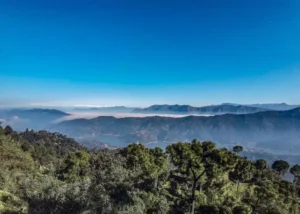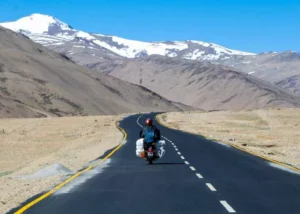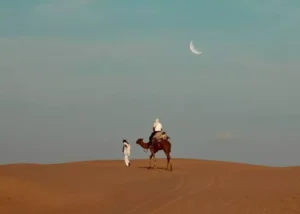About 10 Unusual Travel Facts That Will Blow Your Mind
Traveling is the most common form of leisure. And, people like vacationing to exotic places. But have you ever wondered or asked yourself what’s the significance of those colorful prayer flags? Or, what’s the story behind the name Sonamarg? Traveling is fun, but it is also juiced with interesting travel facts. Unfortunately, most of the time it happens when we are so spell bounded by the views that we simply chose to ignore these interesting travel facts. This leads to forgetting about the real meaning or reason behind a name or a destination.
India is abundant with such destinations and these little-known information will help you broaden your travel knowledge. And it’s like knowing your destination from the core.
Here’s the list of amazing travel facts you need to know before planning your next vacation.
1. PRAYER FLAGS

A Tibetan prayer flag is a colourful rectangular cloth that is commonly found strung along Himalayan trails and peaks. They are used for a variety of purposes, including blessing the surrounding countryside. Woodblock-printed text and pictures, which are actually mantras and prayers set in a specific colour order of five, can be found on traditional prayer flags. Each of the five colours corresponds to one of the five Chinese elements. Blue represents the sky and space, white represents the air and wind, red represents fire, green represents water, and yellow represents the earth.
There are two types of prayer flags: horizontal Lung ta (Wylie: rlung-rta, meaning “Wind Horse”) and vertical Darchog (Wylie: rlung-rta, meaning “Wind Horse”) (Wylie: dar-lcog, meaning “flagstaff”). It’s a popular misconception that these flags contain prayers to the gods. Tibetans believe that the prayers and mantras will be carried by the wind across the world, spreading goodwill and compassion. The blessings depicted on the flags are thus taken away to all beings by hanging them in high places.
And, as the photos disappear from exposure to the elements, it is assumed that the prayers of a flag become a permanent part of the world until they have disappeared. Where the old prayer flags should be burned and new ones installed. Finally, keep in mind that the icons and mantras on prayer flags are sacred and should be respected. They should not be used on clothes or on the field. So it is one of the Travel Facts.
2. CHORTENS

In Buddhism, a chorten or stupa is a sacred shrine that represents Buddha’s presence. It also houses priceless Buddhist relics and, on rare occasions, the preserved bodies of illustrious lamas. The Stupa’s form depicts Buddha wearing a crown and sitting on a lion throne in a meditation pose. The crown is at the spire’s peak, with the well-known twin-symbol’ uniting the sun and moon, and his head is the square at the spire’s base, his body is represented by the vase shape, his legs by the lower terrace’s four steps, and his throne by the square foundation base. So it is also one of the Travel Facts.
There are eight different types of chortens in Tibetan Buddhism, each representing a significant event in Buddha’s life.
Buddha’s birth is commemorated by the Lotus Blossom Stupa, also known as the Stupa of Heaped Lotuses.
Enlightenment Stupa, also known as the Stupa of the Conquest of Mara, commemorates the period when Buddha attained enlightenment under the Bodhi tree in Bodh Gaya.
Stupa of Many Doors or Gates is about his story near Sarnath, when Buddha preached his teachings to his disciples. Through the doors on this monument, which reflect the opening of the doors to Dharma, the four noble truths, the Noble Eightfold Path, the Twelve Links in the Chain of Dependent Origination, and the Six Perfections are all taught.
Stupa of Descent from the God Realm which represents the time when Buddha’s mother was reincarnated in a different realm, and he went to teach her the Dharma. This chorten, which has a ladder on each foot, commemorates Buddha’s return to earth.
Stupa of Great Miracles or Stupa of Conquest of the Tirthikas is when Buddha was 50 years old, he performed a series of miracles to demonstrate his faith, including defeating a number of demons.
Stupa of Reconciliation is an octagonal chorten that commemorates Buddha’s attempts to resolve a dispute among his monastic disciples. It was constructed in the kingdom of Magadha, where the dispute was resolved.
Stupa of Complete Victory is a chorten with three undecorated circular phases commemorated as Buddha’s three-month life extension after his followers pleaded with him to stay.
Stupa of Nirvana depicts Buddha’s death and ascension into enlightenment. This monument is unadorned and appears to be in the form of a bell.
3. TAWANG MONASTERY – Largest monastery in India

Tawang Monastery is India’s largest and the world’s second largest monastery, after the Potala Palace in Lhasa, Tibet. Situated in Tawang, Arunachal Pradesh, the monastery is enclosed by a 925 feet (282 m) long compound wall, the three storey monastery has 65 residential buildings and a library with valuable old scriptures, mainly Kangyur and Tengyur. In Tibetan, Twang Monastery is known as Gaden Namgyal Lhatse, which translates to “celestial paradise in a clear night.” So it is also one of the Travel Facts.
Founded by Merak Lama Lodre Gyatso in 1680-1681 in accordance with the wishes of the 5th Dalai Lama, Ngawang Lobsang Gyatso, the full name of the monastery is Tawang Galdan Namgye Lhatse. The words ‘Ta’ and ‘wang’ mean “horse” and “chosen,” respectively, forming the phrase “Tawang,” which means “horse-selected place.” ‘Gadan’ means “paradise,” “Namgyal” means “celestial,” and “Lhatse” means “divine,” among other things. Thus, the full sense of the ‘Tawang Galdan Namgye Lhatse’ is “the heavenly divine paradise chosen by the horse.”
According to one legend, the current Monastery’s location was chosen by a horse belonging to Merag Lama Lodre Gyatso, who was on a mission to establish a Monastery assigned to him by the 5th Dalai Lama. Unable to find, he sought divine intervention to choose the site. Later in the story, he found his missing horse grazing at the top of a mountain called Tana Mandekhang, which he took as a divine sign and decided to establish the monastery at that location.
Terton Pema Lingpa, treasure diviner, is the subject of the second legend about the origin of the name Tawang. He is said to have provided “initiations” of Tamdin and Kagyad at this spot, leading to the name “Tawang.” “Tamdin” is abbreviated as “Ta,” and “Wang” means “initiation.” Another legend claims that a white horse belonging to the Prince of Lhasa wandered into the Monpa area. People searching for the horse discovered it grazing near the monastery’s current site. People in the region began to worship the horse and the spot where it was discovered, and they continued to do so every year. The Tawang Monastery was eventually established on the holy site to honour it.
Another legend is that of the goddess Palden Lhamo. According to legend, this female deity, who is often compared to the Hindu Goddess Kali, lived in Sri Lanka as the consort of a demon king who performed human sacrifice. She left the kingdom because she did not agree with this procedure. The king shot her with an arrow as she was fleeing, hitting the backside of the mule she was riding. When she drew the arrow, it left a gaping hole in the mule’s back, from which Palden Lhamo could observe Lord Buddha’s teachings.
4. SONAMARG – The Golden Meadow

Sonamarg is a Hindi word that means “beautiful land” and is a popular tourist destination in Jammu and Kashmir. Gold is represented by sona, and a meadow is represented by marg. During the spring season, the valley is famous for its carpets of lush yellow flowers. And when the sun shines on them at sunrise and sunset, the whole field appears to be a golden meadow. The valley and nearby areas will be carpeted in yellow flowers, earning it the nickname “gold valley.” So it is also one of the Travel Facts.
According to ancient literature, Sonamarg and the surrounding areas were part of the popular silk route that connected India and Tibet. Sonamarg is very close to the Zojila Pass, which passes between Srinagar and Leh. As a result, this region was a prominent trading destination in ancient times. Sonamarg was once a well-kept secret in Kashmir, but it is now a popular tourist destination, especially for adventurers.
5. MOHAN – The ancestor of ‘All’ white tigers

Do you know how the first white tiger came to be? To your delight, all white tigers are Bengal tigers. Yes, you understood that correctly. White tigers are a genetic variation of the Indian Bengal Tiger, not a distinct subspecies. The origin of the white tiger can be traced back to 1556 A.D. to 1605 A.D., and it was a result of both parents having the recessive gene for white colouring. The Maharaja of Rewa founded the first mutant white tiger in 1915, and held the tiger cub until it died.
The tiger, named Mohan, mated with a normal-colored tigress and had three normal-colored offspring. After a few years, Mohan mated with one of the offspring, and the first litter of white cubs was born. These white cubs were then relocated to various zoos around the world, where they became the forerunners of today’s white cubs.
6. ZIRO MUSIC FESTIVAL- India’s greatest outdoor music festival

The Ziro Music Festival is an outdoor music festival in India that features independent artists from all over the world. It takes place in the lush green valley of Arunachal Pradesh. This festival brings together some of India’s best-known musical artists, as well as a diverse audience to watch them perform. The Ziro Music Festival is a one-of-a-kind experience that combines vibrant culture, music, and art in a unique way. The Apatani tribe in Ziro hosts the four-day festival, which was created in 2012 by Bobby Hano and Menwhopause guitarist Anup Kutty. So it is also one of the Travel Facts.
The Apatani tribe of the Ziro valley is known for its hospitality and musical prowess. The Ziro Music Festival satisfies the need for a well-organized music festival as well as the need to enjoy music. The festival attracts music fans from all over the world. The festival, which is known for its high levels of energy and enthusiasm, not only allows the North East to showcase its talent and music, but it also encourages tourism in the region.
7. JATINGA VILLAGE- “Suicide Spot” of Birds

Jatinga is a small tribal village in Assam, India, located 330 kilometres south of Guwahati in the Dima Hasao district. Jatinga is popular around the world for the unusual behaviour of the birds that occurs every year from September to November. And we mean it by calling it and ‘Unusual Behaviour’. So it is also one of the Travel Facts.
The location appears to serve as a Bermuda Triangle of fowl death for the animals. The villagers were surprised to find swarms of birds flocking around the flaming torches when they first noticed them in 1905. Hundreds of thousands of birds have died in Jatinga over the last century. Despite studies by some of India’s most prestigious ornithologists, this phenomenon remains an unsolved mystery.
8. ZOJI LA- Only pass named after a God

Zoji La is nothing like a Sunday trip, with its status as one of the world’s most dangerous mountain roads. Zoji La, one of the high mountain passes, is located in the Kargil district of Ladakh, India, at an elevation of 11,575 feet above sea level. The path to the summit is unpaved and considered one of the world’s most dangerous passes. It’s known as National Highway 1 (NH1), and it’s a one-of-a-kind spectacular mountain road pass with breathtaking views and thrilling moments. So it is also one of the Travel Facts.
But, putting all of that aside, did you know that the name Zoji La is actually named after a god? As a result, it is the only pass in the world named after a deity. You may be wondering who the lucky god is at this stage. Lord Shiva is the one and only. As per the old record houses and local tale, the Pass was originally called Shivji La (La stands for Pass), but in time and dialect change, the name later changed to Zoji La. Just like the quote from the famous TV series Game of Thrones, the quote “Hold the Door” was changed to “Hodor.”
9. TIGER HILLS – Witness Mt. Everest from Darjeeling
Darjeeling, also known as the “Queen of the Hills,” is a wonderful place to visit if you want to be one with nature. The gleaming Mt Kanchenjunga towers over the azure sky, nestled among the rolling mountains. Darjeeling tea, which has a muscatel flavour and is covered by tea connoisseurs all over the world, is produced here. The heritage Darjeeling Himalayan Railway is housed here, and the Tiger Hills have an outstanding sunrise view.
The Tiger Hill is particularly important because it offers views of Mount Everest as well as Kanchenjunga, the world’s third highest mountain. Imagine seeing some of the world’s highest peaks in one panoramic view, with a mesmerising sunrise view to round out the experience. The Kanchenjunga, however, appears to be higher than Everest. Because of the earth’s curvature and Kanchenjunga’s proximity to Everest, Kanchenjunga is closer than Everest.
10. KAGBHUSANDI LAKE- Lake where the Crow perishes

Kagbhusandi Tal is a lovely oblong lake at a high altitude with emerald green waters and breathtaking mountain views. This glacial lake is cradled at the bottom of Hathi Parvat (6730 m), one of the most prominent Himalayan peaks of all the Six Thousanders, at an elevation of 4730 m. Its water has a striking greenish hue, and flower blooms in varying shades of pink, mauve, brown, purples, crimson, ochre, rust, and greens cover its banks. Because of its remoteness, there’s a good chance you’ll see wildlife, especially bears. This hike provides panoramic views of the region’s numerous Himalayan peaks.
The trek’s other highlight is a pair of massive irregular rocks on a spur of Hathi Parvat that are frequently referred to as a crow (Kaga) and an Eagle (Garuda). The crow is said to be animatedly conversing with Garuda about the affairs of the world, according to local legend. According to another legend, a learned Brahmin from Ayodhya once angered the sage Lomas, who lived near the lake, and was transformed into a crow by the sage. Local folklore tells of a spot where crows migrate to their deaths, as well as many other mysteries. Strangely, despite the fact that the whole area is littered with broken feathers, no one has ever seen a crow die here at the lake.
Mysterious. Isn’t it?
So this was the blog about Travel Facts of Moustache Escapes. We hope you find these facts similarly as interesting as finding it while researching and writing. Traveling is fun, but is more than just visiting places. You can experience and learn a lot of intriguing facts if you start digging out the story behind a particular destination. And we are sure, you have somewhere at one point of your journey encountered one of these curious travel backstories. Make sure to share your share of facts you’ve ever explored and get featured on our next blog. For more such unique travel experiences and tales keep reading our blog.
Until then, keep reading, and keep traveling!





